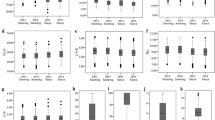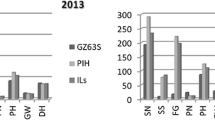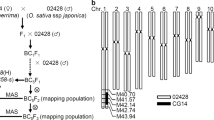Abstract
Although pronounced heterosis in inter-subspecific hybrids was known in rice for a long time, its utilization for hybrid rice breeding has been limited due to their hybrid sterility (HS). For the last two decades, however, a few inter-subspecific hybrids have been developed by incorporating wide-compatibility genes (WCG) that resolve HS, into parental lines of these inter-subspecific hybrids. For effective use of WCG, it is necessary to find convenient markers linked to WCG of practical importance. In this paper, initially a set of simple sequence repeat (SSR) markers in the vicinity of known WCG loci identified based on comparative linkage maps have been surveyed in a population derived from the three-way cross- IR36/Dular//Akihikari, where a known donor of WCG Dular was crossed to a representative indica and japonica cultivar. Of the five parental polymorphic markers, RM253 and RM276 were found to be closely linked to the WCG locus S5 at a distance of 3.0 and 2.8 cM, respectively. Later, loci for HS were examined in three F2 populations derived from inter-subspecific crosses, with same set of SSR markers. The locus S8 was confirmed to have major influence on HS in the F2 population derived from CHMRF-1/Taichung65 since two SSR markers in its vicinity, RM412 and RM141, co-segregated with HS at a map distance of 7.6 and 4.8 cM, respectively. In the F2 population derived from the cross BPT5204/Taipei309, three SSR markers in the vicinity of S5, RM50, RM276 and RM136 co-segregated with HS at a map distance of 4.2, 3.2 and 7.8 cM, respectively. In the third F2 population derived from Swarna/Taipei309, the SSR markers in the vicinity of S5, RM225, RM253, RM50, RM276 and RM136 were identified to co-segregate with HS at a map distance of 3.2, 2.6, 3.4, 2.6 and 6.6 cM, respectively. These results indicated a clear picture of WCG in Dular as well as the predominant role of HS alleles at S5 locus. The identified SSR markers are expected to be used for incorporation of WCG into parental lines in hybrid rice breeding to solve HS in inter-subspecific hybrids.


Similar content being viewed by others
References
Chen X, Temnykh S, Xu Y, Cho YG, McCouch SR (1997) Development of microsatellite framework map providing genome wide coverage in rice (Oryza sativa L). Theor App Genet 95:553–567
Devanand PS, Rangaswamy M, Ikehashi H (2000) Identification of hybrid sterility gene loci in two cytoplasmic male sterile lines in rice. Crop Sci 40:640–646
Heuer S, Miézan KM (2003) Assessing hybrid sterility in Oryza glaberrima( O sativa hybrid progenies by PCR marker analysis and crossing with wide compatibility varieties. Theor Appl Genet 107:902–909
Ikehashi H, Araki H (1986) Genetics of F1 sterility in remote crosses of rice. In Rice Genetics IRRI:119–130
Joshi SP, Ranjekar PK, Gupta VS (1999) Molecular markers in plant genome analysis. Curr Sci 77:230–240
Kato S, Kosaka H, Hara S (1928) On the affinity of rice varieties as shown by the fertility of hybrid plants. Bull Sci Fakult Terkult Kyushu Imp Univ 3:132–147
Kosambi DD (1944) The estimation of map distance from recombination values. Ann Eugen 12:172–175
Kubo T, Yoshimura A (2001) Linkage analysis of a gene controlling F2 sterility in japonica/ indica backcross progenies of rice. Rice Genet Newsl 18:52–53
Kubo T, Eguchi M, Yoshimura A (2000) A new gene for F1 pollen sterility in japonica/ indica cross of rice. Rice Genet Newsl 17:63–64
Kubo T, Eguchi M, Yoshimura A (2001) A new gene for F1 pollen sterility on chromosome12 in japonica/ indica cross of rice. Rice Genet Newsl 18:54–55
Lander ES, Green P, Abrahmson J, Barloe A, Daly MJ, Lincoln SE, Newburg L (1987) MAPMAKER: an interactive computer package for constructing primary linkage maps of experimental and natural populations. Genomics 1:174–181
Lu CG, Takabatake K, Ikehashi H (2000) Identification of segregation distortion neutral alleles to improve pollen fertility of indica-japonica hybrids in rice. Euphytica 113:101–107
McCouch SR, Leonid T, Yunbi X, Katarzyna BL, Karen C (2002) Development and mapping of 2240 New SSR markers for Rice (Oryza sativa L.). Theor Appl Genet 109:199–207
Nagato Y, Yoshimura A (1998) Report of the committee on gene symbolization, nomenclature and linkage groups. Rice Genet Newsl 15:13–74
Roder MS, Plaschke J, Konig SU, Borner A, Sorrells ME, Tanksley SD, Ganal MW (1998) Abundance, variability and chromosomal location of microsatellites in wheat. Mol Genet 246:327–333
Sambrook J, Russell DW (2001) Molecular cloning: a laboratory manual 3rd edn. Cold Spring Harbor, NY, USA pp 5.40–5.46
Sano Y (1993) Is an egg killer present in rice. Theor Appl Genet 86:1038–1042
Sano Y, Eiguchi M, Hirano HY (1992) Genetic elimination found in the indica-japonica hybrid of rice. Jpn J Breed 42:454–455
Sobrizal Y, Matsuzaki P, Yoshimura A (2002) Mapping of pollen semi-sterility gene S-28 (t) on rice chromosome 4. Rice Genet Newsl 19:34–37
Taguchi K, Doi K, Yoshimura A (1999) RFLP mapping of S-19, a gene for F1 pollen sterility found in back cross progeny of Oryza sativa and O.glaberrima. Rice Genet Newsl 16:70–71
Wan J, Ikehashi H (1995a) Identification of a new locus S-16 causing hybrid sterility in native rice varieties (Oryza sativa L.) from Tai-hu lake region and Yunnan Province, China. Breed Sci 45:461–470
Wan J, Ikehashi H (1995b) Loci for hybrid sterility in Basmati crosses. Intl Rice Res Notes 20:4
Wan J, Yanagihara S, Kato H, Ikehashi H (1993) Multiple alleles at a new locus causing hybrid sterility between Korean indica variety and a javanica variety in rice (Oryza sativa L.). Jap J Breed 43:507–516
Wan J, Yamaguchi Y, Kato H, Ikehashi H (1996) Two new loci for hybrid sterility in rice (Oryza sativa L.). Theor Appl Genet 92:183–190
Wang J, Liu KD, Xu CG, Li XH, Zhang Q (1998) The high level of wide compatibility of variety ‘Dular’ has a complex genetic basis. Theor Appl Genet 97:407–411
Williams CE, Yanagihara S, McCouch SR, Mackill D, Ronald PC (1997) Predicting success of indica/japonica crosses in rice based on a PCR marker for the S-5 n allele at a hybrid-sterility locus. Crop Sci 37:1910–1912
Yanagihara S, Kato H, Ikehashi H (1992) A new locus for multiple alleles causing hybrid sterility between an Aus variety and javanica varieties in rice (Oryza sativa L.). Jap J Breed 42:793–801
Yanagihara S, Couch SR, Ishikawa K, Ogi Y, Maruyama K, Ikehashi H (1995) Molecular analysis of the inheritance of the S-5 locus conferring wide compatibility in indica/japonica hybrids of rice (Oryza sativa L.). Theor Appl Genet 90:182–188
Yuan LP (1992) The strategy of the development of hybrid rice breeding. In: Yuan LP (ed) Current stratus of two line hybrid rice research 1–5, In Chinese, English summary. Agricultural Publishing Ltd, Beijing
Zheng K, Huang N, Bennet J, Khush GS (1995) PCR based marker-assisted selection in rice breeding. IRRI Discussion paper series No 12. International Rice Research Institute, Manila
Zhu S, Wang C, Zheng T, Zhao Z, Ikehashi H, Wan J. (2005) New gene located on chromosome 2 causing hybrid sterility in a remote cross of rice. Plant Breed 124:440–445
Acknowledgements
The authors profusely thank Dr. B. Mishra, Project Director, Directorate of Rice Research, Hyderabad for the kind help and assistance received and research facilities extended to pursue the present study.
Author information
Authors and Affiliations
Corresponding author
Additional information
Communicated by T. Sasaki
S.P. Singh , R.M. Sundaram contributed equally
Rights and permissions
About this article
Cite this article
Singh, S.P., Sundaram, R.M., Biradar, S.K. et al. Identification of simple sequence repeat markers for utilizing wide-compatibility genes in inter-subspecific hybrids in rice (Oryza sativa L.). Theor Appl Genet 113, 509–517 (2006). https://doi.org/10.1007/s00122-006-0316-0
Received:
Accepted:
Published:
Issue Date:
DOI: https://doi.org/10.1007/s00122-006-0316-0




